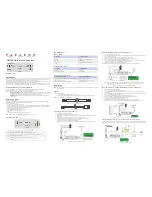
TM-499 Page 2
STEAM AND HOT COOLANT can burn.
D
If possible, check coolant level when engine is
cold to avoid scalding.
D
Always check coolant level at overflow tank, if
present on unit, instead of radiator.
D
If the engine is warm, checking is needed, and
there is no overflow tank, follow the next two
statements.
D
Wear safety glasses and gloves and put a rag over radiator cap.
D
Turn cap slightly and let pressure escape slowly before completely
removing cap.
MAGNETIC FIELDS can affect pacemakers.
D
Pacemaker wearers keep away from servicing
areas until consulting your doctor.
FALLING UNIT can cause injury.
D
Use equipment of adequate capacity to lift and
support unit and components.
D
Use lifting eye to lift unit only, NOT running
gear, gas cylinders, or any other accessories.
D
Securely attach components to lifting equip-
ment.
D
If using lift forks to move unit, be sure forks are long enough to
extend beyond opposite side of unit.
HOT PARTS can cause severe burns.
D
Allow cooling period before servicing.
D
Wear protective gloves and clothing when
working on a hot engine.
D
Do not touch hot engine parts bare-handed.
SHOCK HAZARD from testing.
D
Stop engine before making or changing meter
lead connections.
D
Use at least one meter lead that has a self-
retaining spring clip such as an alligator clip.
D
Read instructions for test equipment.
TILTING OR TIPPING can cause injury.
D
Do not put any body part under unit while lifting.
D
Always use proper equipment (hoists, slings,
chains, blocks, etc.) of adequate capacity to lift
and support components (stator, rotor, engine,
etc.) as needed during job.
PINCH POINTS can injure.
D
Be careful when working on stator and rotor assemblies.
H.F. RADIATION can cause interference.
D
High-frequency (H.F.) can interfere with radio
navigation, safety services, computers, and
communications equipment.
D
Have only qualified persons familiar with elec-
tronic equipment perform this installation.
D
The user is responsible for having a qualified electrician prompt-
ly correct any interference problem resulting from the installa-
tion.
D
If notified by the FCC about interference, stop using the equip-
ment at once.
D
Have the installation regularly checked and maintained.
D
Keep high-frequency source doors and panels tightly shut, keep
spark gaps at correct setting, and use grounding and shielding to
minimize the possibility of interference.
OVERUSE can cause OVERHEATING.
D
Allow cooling period; follow rated duty cycle.
D
Reduce current or reduce duty cycle before
starting to weld again.
D
Do not block or filter airflow to unit.
READ INSTRUCTIONS.
D
Use Testing Booklet (Part No. 150 853) when
servicing this unit.
D
Consult the Owner’s Manual for welding safety
precautions.
D
Use only genuine replacement parts.
D
Reinstall injectors and bleed air from fuel system according to
engine manual.
1-3. California Proposition 65 Warnings
Y
Welding or cutting equipment produces fumes or gases which
contain chemicals known to the State of California to cause
birth defects and, in some cases, cancer. (California Health &
Safety Code Section 25249.5 et seq.)
Y
Battery posts, terminals and related accessories contain lead
and lead compounds, chemicals known to the State of
California to cause cancer and birth defects or other
reproductive harm. Wash hands after handling.
For Gasoline Engines:
Y
Engine exhaust contains chemicals known to the State of
California to cause cancer, birth defects, or other reproductive
harm.
For Diesel Engines:
Y
Diesel engine exhaust and some of its constituents are known
to the State of California to cause cancer, birth defects, and
other reproductive harm.
1-4. EMF Information
Considerations About Welding And The Effects Of Low Frequency
Electric And Magnetic Fields
Welding current, as it flows through welding cables, will cause electro-
magnetic fields. There has been and still is some concern about such
fields. However, after examining more than 500 studies spanning 17
years of research, a special blue ribbon committee of the National
Research Council concluded that: “The body of evidence, in the
committee’s judgment, has not demonstrated that exposure to power-
frequency electric and magnetic fields is a human-health hazard.”
However, studies are still going forth and evidence continues to be
examined. Until the final conclusions of the research are reached, you
may wish to minimize your exposure to electromagnetic fields when
welding or cutting.
To reduce magnetic fields in the workplace, use the following
procedures:
1. Keep cables close together by twisting or taping them.
2. Arrange cables to one side and away from the operator.
3. Do not coil or drape cables around your body.
4. Keep welding power source and cables as far away from
operator as practical.
5. Connect work clamp to workpiece as close to the weld as
possible.
About Pacemakers:
Pacemaker wearers consult your doctor first. If cleared by your doctor,
then following the above procedures is recommended.







































